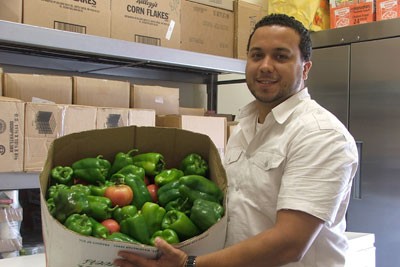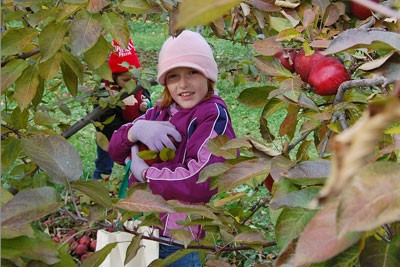Farmers and food banks team up to feed the hungry
By Stacey Shackford
A new collaboration among farmers and New York state's food banks hopes to increase the amount of food donated directly from those who produce our food to those who need it most.
The Cornell Gleaning Project was launched in summer 2011 to help farmers who wanted guidance about the opportunities and obstacles that crop gathering and donation provide.
Gleaning dates to the medieval feudal system, when farmers and landowners were encouraged or required to allow the poor to gather crops remaining in the field after harvest. These days, gleaning generally refers to the collection of food left behind in fields because of mechanical harvesting losses, cosmetic blemishes or lack of markets for the crops, or from farmers' packing lines and storage houses.
New York farmers already donate a large amount of food — more than 5.6 million pounds in 2010, according to the New York Farm Bureau.
"Although many farmers have expressed a strong desire to increase donations from their farm, they are also wary about the potential liability of allowing volunteer harvesters on private property," said Rebecca Schuelke Staehr, coordinator of the Cornell Gleaning Project.
Research conducted by the group — a collaboration between Cornell Cooperative Extension, the New York State Agricultural Experiment Station in Geneva and the Cornell University Agricultural Experiment Station — found several limiting factors, including access to gleaning programs and suitable logistics. In a report presented to the New York State Council on Food Policy, they also noted that in some cases, it is useful for unharvested crops to be left in the field to decompose and add organic matter back to the soil or to suppress weeds and reduce erosion.
But they also uncovered many benefits of gleaning throughout the food supply chain.
Globally, some 1.3 billion tons — one-third of all food produced for human consumption — is wasted through the food supply chain, according to the United Nations.
It's difficult to estimate how much food goes to waste at the farm level, Staehr said. A 1997 report by the USDA Economic Research Service stated that an average 7 percent of U.S. planted acreage is not harvested each year, but much of this was due to weather damage, and most of the food could not be recovered for human use. Still, a small percentage of unharvested crops could equal thousands, or millions, of tons of food in some years, Staehr noted.
Food bank directors, in particular, are interested in New York farmers as sources of food for donation because the food is locally grown, farmers are perceived to be community-minded and New York lacks the volume of food processing and manufacturing facilities that are sources of donations in other states, she said.
The eight regional food banks that comprise the Food Bank Association of New York State distribute food to 5,000 pantries, emergency food kitchens, low-income senior nutrition programs and other hunger relief agencies, feeding more than 3 million people annually.
"We have got to go to the source to get food donations. The more money that is invested in the product as it moves through the supply chain, the harder it is to get it donated," said Peter Ricardo, director of special nutrition projects for the Food Bank of Central New York.
Food bank directors and others are working with the Cornell Gleaning Project to work out logistics and implement a gleaning pilot project. They also hope to develop guidelines for farmers who want to donate food, Staehr said.
Stacey Shackford is a staff writer at the College of Agriculture and Life Sciences.
Media Contact
Get Cornell news delivered right to your inbox.
Subscribe
